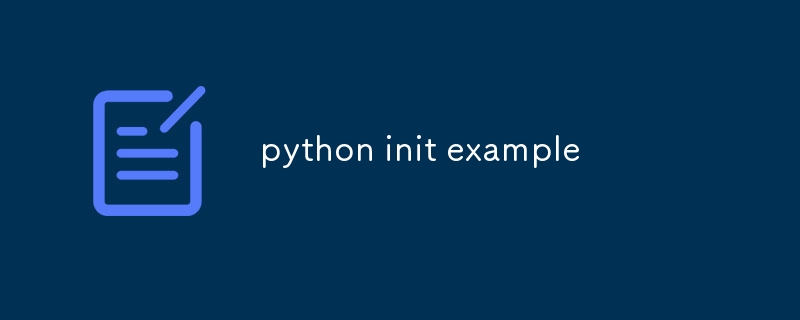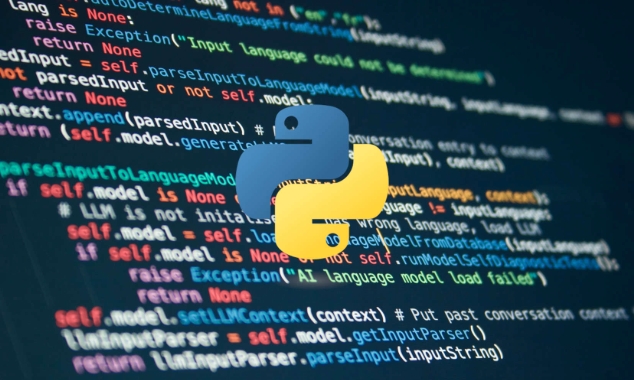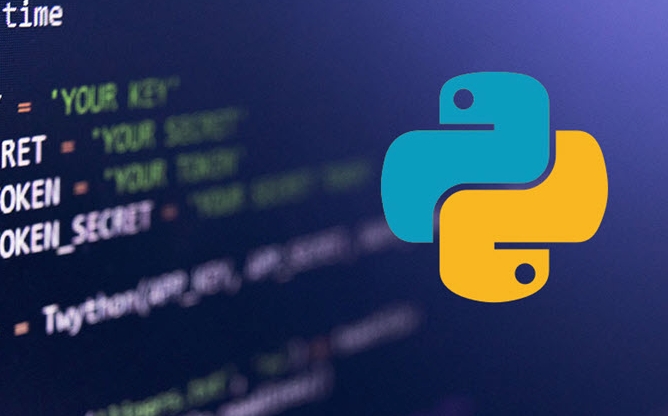init is a method used in Python to initialize object properties. 1. When creating an instance of the class, __init__ is automatically executed, which is used to set the initial state of the object, such as binding the parameter to the instance through self.name = name. 2. You can set default values for parameters, such as breed="Unknown" and age=1 in the Dog class, making initialization more flexible. 3. Logical verification can be added to init, such as the BankAccount class checks whether balance is negative, improving data security. 4. Note that init is an initialization method rather than a constructor. The object already exists before the method is executed and must be spelled correctly and cannot be written as int or init___. Proper use of __init allows classes to have flexible and robust initial configuration when instantiating, thereby effectively managing object state.

__init__ is a constructor of a class in Python that is used to initialize properties when creating an object. Here is a simple and practical example to help you understand how to use __init__ correctly.

What is __init__ ?
When you create an instance of a class, the __init__ method is automatically executed to set the initial state of the object (such as assignment properties).
Basic usage example: Defining a person's class
class Person:
def __init__(self, name, age):
self.name = name
self.age = age
# Create instance person1 = Person("Alice", 30)
person2 = Person("Bob", 25)
print(person1.name, person1.age) # Output: Alice 30
print(person2.name, person2.age) # Output: Bob 25? illustrate:

-
__init__receivesself(representing the instance itself),nameandageas parameters. -
self.nameandself.agebind values to instances, which can be accessed through instances later.
__init__ with default value
You can also set default values for parameters to make initialization more flexible.
class Dog:
def __init__(self, name, breed="Unknown", age=1):
self.name = name
self.breed = breed
self.age = age
# Use the default value dog1 = Dog("Buddy")
dog2 = Dog("Max", "Golden Retriever", 5)
print(dog1.name, dog1.breed, dog1.age) # Buddy Unknown 1
print(dog2.name, dog2.breed, dog2.age) # Max Golden Retriever 5In this way, even if certain parameters are not passed, there will be no errors.

Type checking or initialization logic in __init__
You can add simple verification or processing logic to __init__ :
class BankAccount:
def __init__(self, owner, balance=0):
self.owner = owner
if balance < 0:
raise ValueError("Balance cannot be negative")
self.balance = balance
def deposit(self, amount):
self.balance = amount
def withdraw(self, amount):
if amount > self.balance:
raise ValueError("Insufficient balance")
self.balance -= amount
# Use example account = BankAccount("Zhang San", 100)
account.deposit(50)
account.withdraw(30)
print(account.balance) # 120 In this example, __init__ not only assigns values, but also performs data legality checks.
Things to note
-
__init__is not a "constructor", but a "initialization method". The object is created before__init__is executed. - Do not write it as
__int__or__init___, the spelling must be correct. - If the class does not define
__init__, Python will use the parent class's (such as the defaultobject.__init__).
Basically that's it. The core of __init__ is: when creating an object, set the initial value . Using it well can make the class more flexible and robust.
The above is the detailed content of python init example. For more information, please follow other related articles on the PHP Chinese website!

Hot AI Tools

Undress AI Tool
Undress images for free

Undresser.AI Undress
AI-powered app for creating realistic nude photos

AI Clothes Remover
Online AI tool for removing clothes from photos.

Clothoff.io
AI clothes remover

Video Face Swap
Swap faces in any video effortlessly with our completely free AI face swap tool!

Hot Article

Hot Tools

Notepad++7.3.1
Easy-to-use and free code editor

SublimeText3 Chinese version
Chinese version, very easy to use

Zend Studio 13.0.1
Powerful PHP integrated development environment

Dreamweaver CS6
Visual web development tools

SublimeText3 Mac version
God-level code editing software (SublimeText3)
 VSCode settings.json location
Aug 01, 2025 am 06:12 AM
VSCode settings.json location
Aug 01, 2025 am 06:12 AM
The settings.json file is located in the user-level or workspace-level path and is used to customize VSCode settings. 1. User-level path: Windows is C:\Users\\AppData\Roaming\Code\User\settings.json, macOS is /Users//Library/ApplicationSupport/Code/User/settings.json, Linux is /home//.config/Code/User/settings.json; 2. Workspace-level path: .vscode/settings in the project root directory
 How to handle transactions in Java with JDBC?
Aug 02, 2025 pm 12:29 PM
How to handle transactions in Java with JDBC?
Aug 02, 2025 pm 12:29 PM
To correctly handle JDBC transactions, you must first turn off the automatic commit mode, then perform multiple operations, and finally commit or rollback according to the results; 1. Call conn.setAutoCommit(false) to start the transaction; 2. Execute multiple SQL operations, such as INSERT and UPDATE; 3. Call conn.commit() if all operations are successful, and call conn.rollback() if an exception occurs to ensure data consistency; at the same time, try-with-resources should be used to manage resources, properly handle exceptions and close connections to avoid connection leakage; in addition, it is recommended to use connection pools and set save points to achieve partial rollback, and keep transactions as short as possible to improve performance.
 Mastering Dependency Injection in Java with Spring and Guice
Aug 01, 2025 am 05:53 AM
Mastering Dependency Injection in Java with Spring and Guice
Aug 01, 2025 am 05:53 AM
DependencyInjection(DI)isadesignpatternwhereobjectsreceivedependenciesexternally,promotingloosecouplingandeasiertestingthroughconstructor,setter,orfieldinjection.2.SpringFrameworkusesannotationslike@Component,@Service,and@AutowiredwithJava-basedconfi
 Python for Data Engineering ETL
Aug 02, 2025 am 08:48 AM
Python for Data Engineering ETL
Aug 02, 2025 am 08:48 AM
Python is an efficient tool to implement ETL processes. 1. Data extraction: Data can be extracted from databases, APIs, files and other sources through pandas, sqlalchemy, requests and other libraries; 2. Data conversion: Use pandas for cleaning, type conversion, association, aggregation and other operations to ensure data quality and optimize performance; 3. Data loading: Use pandas' to_sql method or cloud platform SDK to write data to the target system, pay attention to writing methods and batch processing; 4. Tool recommendations: Airflow, Dagster, Prefect are used for process scheduling and management, combining log alarms and virtual environments to improve stability and maintainability.
 Understanding the Java Virtual Machine (JVM) Internals
Aug 01, 2025 am 06:31 AM
Understanding the Java Virtual Machine (JVM) Internals
Aug 01, 2025 am 06:31 AM
TheJVMenablesJava’s"writeonce,runanywhere"capabilitybyexecutingbytecodethroughfourmaincomponents:1.TheClassLoaderSubsystemloads,links,andinitializes.classfilesusingbootstrap,extension,andapplicationclassloaders,ensuringsecureandlazyclassloa
 How to work with Calendar in Java?
Aug 02, 2025 am 02:38 AM
How to work with Calendar in Java?
Aug 02, 2025 am 02:38 AM
Use classes in the java.time package to replace the old Date and Calendar classes; 2. Get the current date and time through LocalDate, LocalDateTime and LocalTime; 3. Create a specific date and time using the of() method; 4. Use the plus/minus method to immutably increase and decrease the time; 5. Use ZonedDateTime and ZoneId to process the time zone; 6. Format and parse date strings through DateTimeFormatter; 7. Use Instant to be compatible with the old date types when necessary; date processing in modern Java should give priority to using java.timeAPI, which provides clear, immutable and linear
 Using PHP for Data Scraping and Web Automation
Aug 01, 2025 am 07:45 AM
Using PHP for Data Scraping and Web Automation
Aug 01, 2025 am 07:45 AM
UseGuzzleforrobustHTTPrequestswithheadersandtimeouts.2.ParseHTMLefficientlywithSymfonyDomCrawlerusingCSSselectors.3.HandleJavaScript-heavysitesbyintegratingPuppeteerviaPHPexec()torenderpages.4.Respectrobots.txt,adddelays,rotateuseragents,anduseproxie
 Google Chrome cannot open local files
Aug 01, 2025 am 05:24 AM
Google Chrome cannot open local files
Aug 01, 2025 am 05:24 AM
ChromecanopenlocalfileslikeHTMLandPDFsbyusing"Openfile"ordraggingthemintothebrowser;ensuretheaddressstartswithfile:///;2.SecurityrestrictionsblockAJAX,localStorage,andcross-folderaccessonfile://;usealocalserverlikepython-mhttp.server8000tor






